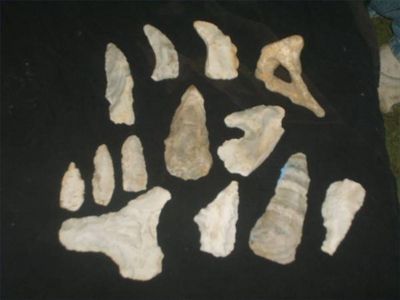Are you interested in identifying Indian artifacts? Do you want to learn how experts and beginners alike are able to identify Indian artifacts? Read our guide for more facts and information…
Why Identify Artifacts
Indian artifacts can be found by almost anyone simply by exploring river beds and areas where Indian populations once lived. Once found these Indian artifacts can be appreciated simply for their inherent design and beauty; however, for many individuals identifying artifacts gives the pieces more personality and offers a greater insight into the history of the piece. By spending the time to identify the Indian artifact that has been found it is possible to discover a story about the artifact that can include insight into the history and culture of the tribe that the piece belonged to. Identifying Indian artifacts may appear to be a daunting task; however, many people have been able to adeptly identify tools or weapons including pottery, axes, arrowheads and spear points by gathering simple information and spending a bit of time doing research.
A Simple Guide to Identifying Artifacts
When identifying artifacts there are four indicators that in combination identify most artifacts; the four indicators are material, shape, design and location. The first indicator of location normally is able to reduce the number of possible identifications substantially. This is because by knowing a state or specific region limits the number of Indian tribes that the artifact could have belonged to. Once you have deduced information based on location, or if this factor is not available to you the next best indicator is the material of the artifact. The material of the artifact can assist in narrowing the search as certain materials are only available in specific regions and only certain tribes had access to specific materials. These first two factors will be of the most assistance in narrowing a large field of possibilities to a smaller pool.
The shape and the design of the artifact should be considered in tandem. For example if you are considering an arrowhead it should be noted whether it is stemmed, stem less or notched. Based on these details clues as to age can be determined as well as which Indian tribe the artifact may have belonged to. In order to come to a conclusive identification a book on artifacts will be necessary. There are many artifact books available either for purchase or at local libraries. When choosing a book to use to assist with identifying artifacts it is popular to choose a book authored by either a known expert or an individual who grew up in Indian culture.
Quick Tips to Identification
Arrowheads are the most common Indian artifact involved in identification as there are 1200+ recorded types of arrowheads. Arrowheads can be dated and identified by examining the design and differing sizes of the arrowheads. Arrowheads have evolved from smaller points into pieces with more jagged edges and narrowed tips. It is also important to consider stone type; however, this is not definitive due to trade between tribes. Pieces of pottery like arrowheads are popular Indian artifacts; however most pottery is often found in shards which makes identification harder and will likely only be correctly done by a seasoned veteran.





